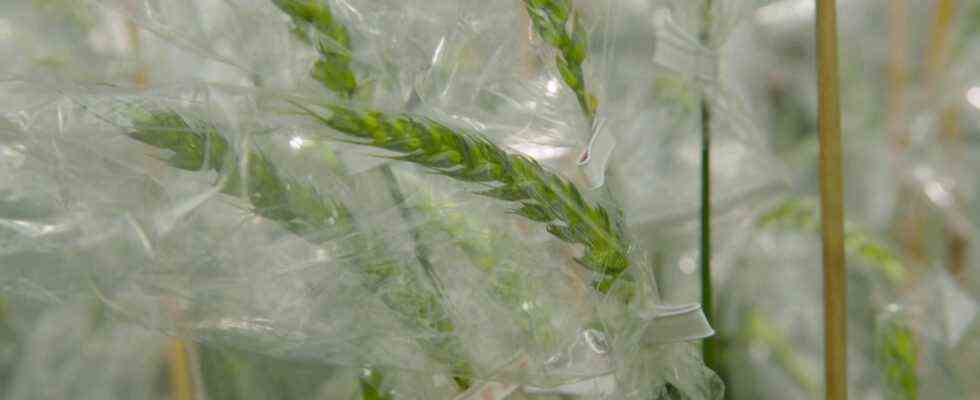background
As of: 27.06.2021 3:51 p.m.
Some say that new genetic breeding methods could revolutionize agriculture. Others see it as an impermissible interference with nature. The much-discussed gene scissors are still rarely used.
The rye stands chest high on the test areas of the Dottenfelder Hof north of Frankfurt. Emmer, an ancient wheat, grows here in many variations – and modern wheat too: Each of the many small plots looks different. Here is the largest research center for organic farming in Germany. Carl Vollenweider is the responsible breeder. For him, genetic engineering is not an option.
“The breeder has 35 to 40 characteristics in mind that they need to be aware of,” he says. Yield, stem length, root formation: everything is related to everything. “It’s almost useless if you only turn one screw. And when you do it, you have to be aware that the other 34 cogs are turning and that you have to see what you have done again.” Whether classic genetic engineering or modern genome editing: For Vollenweider these are pointless attempts to outsmart nature.
Is the gene scissors genetic engineering?
Many conventional breeders, on the other hand, would like to use genome editing with gene scissors. It is, as it were, the editorial revision of the genetic make-up by humans. The difference to previously used genetic engineering methods: Instead of incorporating foreign gene sequences – for example a piece of fish gene into the genetic material of a fir tree or the resistance of a soil bacterium in wheat – the scientists process the material given by the nature of the plant. The question that divides opinions: Is that also genetic engineering – or can this label be left out?
The European Court of Justice ruled three years ago: All of this is subject to the Genetic Engineering Act, and cultivation is strictly prohibited unless the plants have been expressly approved after intensive testing. But now the EU Commission wants to put its 20-year-old genetic engineering law to the test.
In April, she presented a study that came to the conclusion that these novel genetic engineering methods do not pose any greater risks than conventional methods. Another result of the study is that – as far as classification is concerned – there are very different conceivable applications. In some cases the result after using the gene scissors can be clearly identified as a genetic modification – in other cases not. And then it becomes difficult to insist on a label that cannot be controlled in case of doubt.
A lot of research, little application
The large agricultural corporations rely entirely on these methods. In contrast to conventional breeding, the results of genetic engineering processes can be patented – and money can be made with them. Matthias Berninger is chief lobbyist at Bayer AG, which has had the largest private research budget in the world since buying Monsanto at the latest. In three to four years, the group wants to bring a maize variety onto the market that has stronger roots and a shorter stalk. It should be adapted to climate change, says Berninger, because the plant needs less water and can cope better with storms. The promise: 20 percent more yield – or as Berninger prefers to put it: 20 percent less space consumption.
However, much more has been talked about genetic scissors than actually being used. The Joint Research Center of the EU provided an overview of the state of development: According to this, there are more than 400 research projects worldwide. But many of them are only just beginning. So far, there is only one plant in cultivation whose genome has been altered using gene scissors: a soybean with a modified oleic acid pattern.
Stephanie Franck, President of the Federal Association of German Plant Breeders (BDP), is accordingly cautious. The new breeding methods are ascribed the potential to shorten the development of new varieties, she formulates. To find out whether the gene scissors keep their promises, the BDP has started a pilot project with fungus-tolerant wheat. There is considerable interest in the industry: 54 breeding companies want to participate.
Just a small part of the breeding process
One thing is already certain: the technology alone does not make a variety. Both conventional and organic breeders know that. Breeding has always been based on mutations. They occur en masse in nature, but in order to accelerate the change in genetic material, help is provided: for example with radioactive radiation, the use of chemical cocktails – or, more recently, with gene scissors. But the really complicated thing comes afterwards: the desired effects of the mutations must be separated from the undesired ones. The suitability of the entire plant – and not just that of the newly created genetic construct – must be tested in nature. Editing the genome with gene scissors is only a small part of the overall process.
Organic grower Vollenweider sees it this way: also from the point of view of world nutrition, one needs first of all plants that naturally cope with their respective environment and bring a stable yield. Then you need cultivation systems that work under the respective external conditions – and training for the farmers. And before all of this works out, he thinks it makes no sense to use genetic engineering to turn one of the many breeder’s screws. Would it be possible to improve the details later with a pair of gene scissors? He doesn’t completely rule that out.

